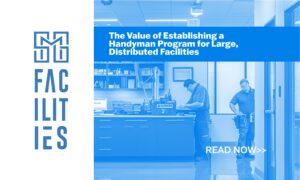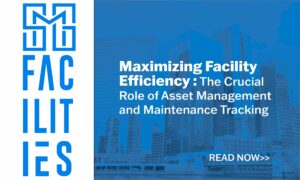Following the stress of COVID-19 and the present curiosity of a second wave of the pandemic, the importance of ensuring a safe facility in the current climate is paramount. The latest facilities management, or FM, trends, and practices, such as technology improvements, data analysis, and strategic outsourcing, can help reach this goal. Let’s take a closer look at these trends and best practices and how to turn them into action by outsourcing.
Creating a Smart Facility and Workplace
While devices connected to the Internet of Things (loT) sound highly futuristic, it has become one of the leading facilities management trends for years. According to Lauren Gilmer via FacilitiesNet, connected, smart systems can help teams “improve efficiency, look for opportunities to turn off unused equipment, replace old inefficient equipment with new technology, use building controls to optimize system runtime, find and fix leaks, [and even] consider more efficient technologies.” Teams can use these new applications of connected technology to make any workspace smarter and easier to manage.
Data-Driven Decision-Making
The value of an intelligent workplace that aligns with the latest trends in facility management doesn’t end with simply controlling assets. Anything connected to the loT generates data. And facility management professionals can apply that data to make more meaningful and informed decisions regarding repair-versus-replacement decisions, when to schedule maintenance, and much more. Proper data analysis kickstarts proactive maintenance of facilities to ensure fewer equipment failures and decreased expenses decrease.
Managing an Accurate Capital Budget
Capital budgeting time adds stress and challenge for facility teams in any organization, primarily relying on outdated condition assessments. Tracking and prioritizing upcoming costs, part of handling the capital budget for repairs, innovations, or replacement of assets, can be overwhelming. However, it is essential to project these costs accurately. Facilities need up-to-date and accurate data to predict what capital improvements need to happen or be deferred for the short-term, such as the next week. It’s further important to realize that in this case, the deferred item is only held for a week, provided it carries a negligible risk of subsequent damage within that duration. Regardless, do not allow any deferred item to remain on the backlog for more than a predefined limit, such as until the beginning of the next month.
Pandemic Protocols Becoming Permanent
Although COVID-19 heightened stress all over the world, numerous benefits did come from the pandemic. Within any facility or organization, safety is a number one priority for all workers and customers. During the pandemic, numerous facilities management practices were put into place to promote the safety of building occupants. These included temperature checks, PPE stations, self-assessment health forms, and deep cleaning routines. Aside from mitigating the risk of illness, sticking to the past year’s pattern will benefit your company. These benefits can further attract more customers, boost employees’ health, and even reduce stress on your assets (if remote working becomes more commonplace in the future).
Leveraging the Power of Analytics
The power of analytics happens when the collected and analyzed data is applied to the facility. Utilizing analytics provides improved efficiency and quality by comprehensively viewing the facility’s details on the current state of assets, resource distribution, and repair or maintenance needs. With efficiency and quality, spending will also decrease comprehensively due to improved hindsight and foresight to continuously learn through the four types of analytics, including
- Descriptive analytics that show what happened.
- Diagnostic analytics that show why something happened.
- Predictive analytics that show what is going to happen.
- Prescriptive analytics that show what needs to happen to achieve the best outcome.
Robots Are the Future, But Drones Are Here
Along with utilizing loT, robot facility monitoring and augmented reality tools will continue to become another leader among FM trends. While these might seem like facilities management future trends, they are already in place today. And activities that are seen as repetitive and follow the same process are prime opportunities to integrate robots into the operation. For example, drones or robots can be beneficial in handling hazardous tasks, such as HVAC duct cleaning, cleaning or inspecting building exteriors, and more. Together, they work in tandem with your team to reduce the risk of commercial property damage.
Augmented Reality Uses Increase
Facilities management has the potential to be transformed through augmented reality (AR) solutions in technology. AR takes visual information, such as viewing an asset via a smartphone app, and uses analytics to diagnose the need or even show team members how to conduct scheduled preventive maintenance. This is an excellent way to help train new team members on needs, and it is further useful when an on-demand technician is unavailable, or other specialized expertise is required for unique needs. For instance, if facilities’ electrical problems cause disruption, AR is on track to teach your team members in real-time how to complete an urgent repair while awaiting professional servicing.
Automated Vendor Tracking and Management Becomes Standard
There are countless tasks that your team must manage, and one of the most critical tasks is to track who’s working on your facility. This is awareness of when contractors arrive and leave a location. Knowing the vendor check-in and out time will validate the work order and how long it took, providing more data to ensure your company pays for services completed based on factual information. A valuable example of check-in and check-out for vendors while also showing the benefits of augmented reality is using a mobile app with a GPS that automatically tracks contractor time, location, and more.
Strategies to Track In-House Parts and Supplies Inventory
The need to do more with less is a leading reason to explain current trends within facilities management that somehow focus on improved visibility. If a facility lacks visibility into its cleaning supplies, replacement parts, or other crucial inventory, it’s challenging to know what your team can handle on demand. Visibility into your inventory of all equipment, components, parts, and supplies will effectively lead to better facility asset management and maintenance.
Improved Collaboration and Communication Across Your Team
Collaboration and communication between all parties are critical within facilities management practices to complete maintenance on time and without added costs. Facilities management teams may set monthly meetings, share updates in real-time across mobile devices, and view analytics-driven reports on demand. The goal of all these activities is to boost collaboration through clear, concise, and timely communication.
Choose SMG Facility Services Align Your Organization With the Current Trends Within Facilities Management
Optimizing modern technology, data-based decisions, and evidence-based best practices like those above will help improve your facilities management and maintenance strategy. However, there’s an even easier way to tap the value of efficiency with less overhead—outsourcing to a proven, integrated facilities service partner like SMG Facility Services. Facilities management teams can achieve the above practices even easier today through the growing evidence to support facilities management outsourcing trends. Outsourcing is growing in popularity with roughly 20% of companies outsourcing their needs, says McKinsey & Company. Contact SMG Facility Services to put those practices to good use without the hassle of building them from the ground up in your organization.





